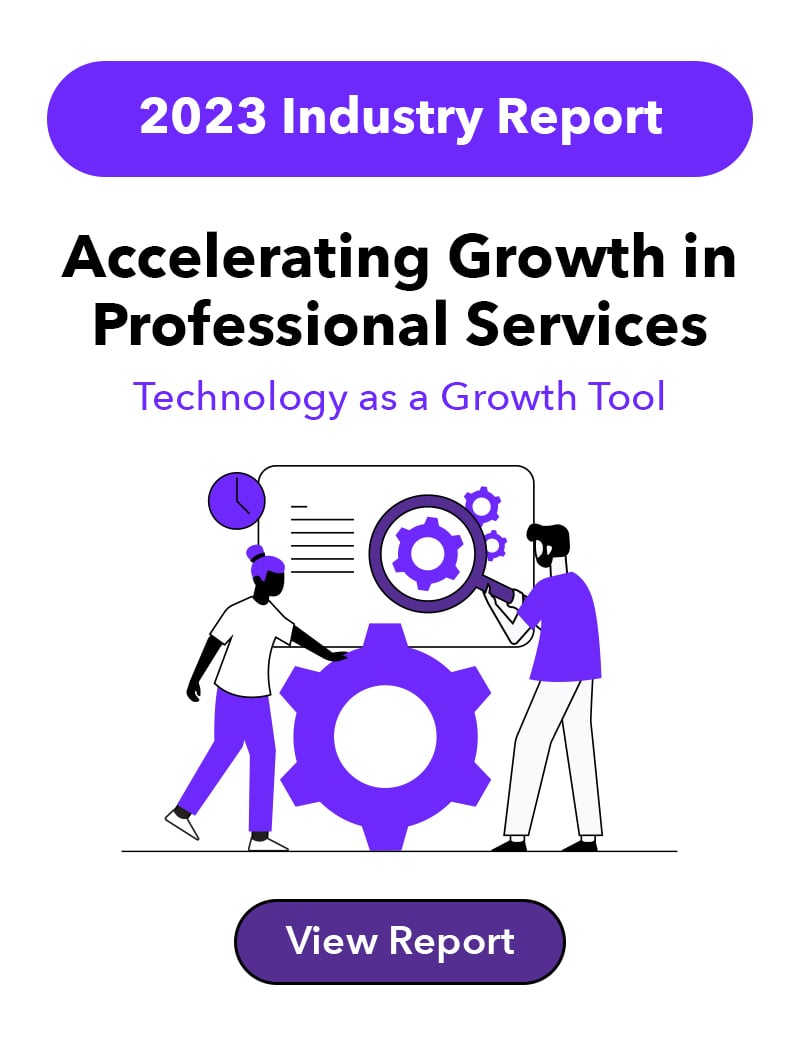As a B2B SaaS marketer, with a few decades of experience, I’m constantly keeping my finger on the pulse of new themes or challenges for the industry.
A few months ago, the Pitchly team hit the convention floor at the International Legal Technology Association Annual Conference (ILTACon). It raised the important question of how marketing and IT can work more collaboratively to generate real growth for their organizations.
It was clear from our conversations with innovative IT leaders that there are many opportunities out there for these typically separate teams to share their like-minded goals and to work more closely.
The connection between marketing tech and IT can be weak at times, but opportunities for efficiencies and ROI are significant. Not to mention the functional overlap between teams; the average marketing team dedicates 23% of its budget to its tech stack. And 21% of their tools are oven times cross-charged with IT.
This makes it all the more important to create a strong connection and communicate about shared goals between these teams. When there’s a disconnect, the organization’s overall go-to-market strategy, client experience and ability to scale are at stake.
While marketing and IT may seem relatively distinct on the surface, once we dig into the top priorities of each department, we begin to uncover a clear overlap. Let’s take a look at what these top priorities are.
Contents
The common thread between marketing and IT
The benefits of cross-department collaboration
Why marketing and IT need to work together
Bringing data into the conversation
How marketing and IT can work together
Top Priorities for Marketing and IT
Marketing
For a full overview of the top priorities of marketing and business development teams
in professional services, check out our industry report
-
Organizational growth through GTM
Ultimately, the goal of marketing is to nurture prospects through and beyond the buying journey to create loyal and repeating customers
One of the most effective methods of delivering on this priority is by creating data-driven synergy between marketing and business development to align messaging and efforts at every step in the funnel. A large task on marketing executives’ plates is co-leading GTM initiatives across new business and client success teams to identify, nurture, close and retain great clients. In roles thus far, teams I’ve led have worked across the organization to look at GTM indicators including customer acquisition cost, lifetime value of a customer. and more. Working collaboratively with sales and services leaders to meet the company’s growth goals by adding new customers to the organization and delighting them has been the ultimate measurement of a successful GTM strategy.
-
Creating a Unique Brand
This is what most people think of when they think of “marketing.” Branding is related to the “meaning” or “feeling” that people associate with your organization. The visuals, messaging and creative elements are tools that are used to communicate about the brand – but they aren’t the brand itself. An effective brand should help differentiate an organization, make a promise to solve a problem and be the map to delivering the promise. A marketing team’s goal is to create a consistent, recognizable and unique brand that connects with the target audience.
Brand management is the underlying theme of everything the marketing team does. Throughout my career, I’ve seen that one of the best ways to reinforce an organization’s brand is to work with clients to share their success stories. Prospective clients value social proof, or stories of other firms, just like them, that have seen an ROI with a solution.
When marketing teams are savvy with their brand strategy execution, they can boost brand awareness and create successful connections with current clients, prospective customers, and future prospects.
-
Digital transformation for scalability
Teams across many organizations are being equipped with less, whether that means fewer resources or fewer team members. At the same time that team resources are waning, these teams have an even larger challenge on their plate to find innovative ways to beat the increasing competition. This makes digital transformation and scalability a vital priority of marketing teams.
There is a big focus on implementing scalable processes and automation to minimize the effect of shrinking resources. What works when an organization is small must be able to scale as the organization grows without putting proportionally more pressure on the team.
Using a solution like Pitchly helps an organization take the data they already have and make it easy to access and take action with. Focusing on automating tedious and time-consuming processes has been a growing investment category for marketing teams and can help them do more with less.
IT
-
Innovation Exploration
IT leaders pride themselves on being at the forefront of innovation. They are typically one of the largest groups of early adopters who examine and assess exciting new tech. Such innovation that has been in development recently could be anything from IoT, the metaverse, Web 3.0 and more.
This hunger for innovation is not simply for novelty, though. It is also a practical strategy for these teams. Staying updated about the latest developments in technology can help teams do more with the systems and data they already have, remain more competitive and be more efficient.
As CIO/EVP of Seagate Technology Ravi Naik said, “When innovation is unleashed, we can unlock the value that is stuck in inefficiencies and allow that value to be reinvested into the company.” -
Streamline to Simplify
One of the main goals of IT teams is to simplify processes to reduce errors and increase efficiency.
Simplification also leads to a much higher rate of technology adoption. At the high end, adoption of new technologies by employees is generally low hovering around 50-60%. Low adoption can be a large barrier to the IT team’s success.
IT teams often look to strategies such as prioritizing ease of use or opting for cloud-based technologies to augment simplicity and adoption.
-
Boost organizational growth
The best and most strategic IT teams have a growth mindset that informs their decisions; they consider how the technology they implement can drive actual business outcomes. According to the Snow Software 2022 IT Priorities Report, driving company growth is on many CIOs lists of top priorities.
One of the main focus areas that augments this priority is data. IT leaders know that data is powerful when it is actionable. They are motivated to find technologies and methods to extract the most value out of their data to inform decision-making and make an impact on their organization’s bottom line.
Executive Vice President and CIO of Momentive (formerly SurveyMonkey), Eric Johnson said of their 2022 plans, “We focused investments in data infrastructure, hiring key skills and key wins [in 2021]. In 2022 we’ll now push to define larger goals and projects to move the needle on critical business KPIs using data science and [machine learning].”
The common thread between marketing and IT: A Growth Mindset
While there is a range of focus areas for both marketing and IT, the idea of pushing the organization toward growth intersects with almost every one of them. And these two departments are both crucial to help set the organization up for success.
Without marketing putting the right strategies in place and IT reinforcing an environment that supports innovation, scalable growth for the organization is not possible. And when these teams work in alignment, the growth possibilities increase tenfold.
Why Marketing and IT Need to Work Together
Benefits of cross-department collaboration in general
Before we discuss the benefits of marketing and IT working together, it’s important to acknowledge the advantages that are realized when cross-department collaboration occurs.
-
Combine diverse skill sets
Different teams will look at situations differently. When multiple perspectives collide, it can bring to light solutions that any one team may not have come to on their own. It increases the variety of skill sets and provides more complete action plans. -
Improve employee engagement.
When people are encouraged and allowed to connect with people from other departments, they enjoy their positions more and work harder. A survey found those team members who collaborate and are given access to tools to make those collaborations successful are 17% happier in their roles than those who work independently.
-
Power innovation.
Because of both the benefits mentioned above, when teams collaborate, innovation emerges. A culture of collaboration helps new solutions arise and allows teams to share their creative solutions back and forth. And as a result, collaborative organizations can stay a few steps ahead of the competition.
Specifically, why should IT and marketing work together?
On average, a third of marketing teams’ budgets are spent on their marketing technology stack. And over a quarter of that martech budget is allocated to operations. That means that not only is technology a crucial consideration for marketing, but the technology selected by marketing also impacts the overall organization.
Technology helps the marketing team best understand the organization’s customers. Without a deep and nuanced understanding of current, prospective and future customers, marketing’s ability to influence is minimal. In a recent industry report, we found that digital transformation was simultaneously a major struggle and a top priority for professional services growth teams.
So when you bring in the IT team to help with not only selecting technology but also with weaving it into marketing processes, the benefits will be felt. And from the IT perspective, collaborating with marketing on their tech stack can help keep efficiency goals in check, ensure proper implementation, as well as potentially discover overlaps in the tech requirements of other departments.
When you take a look at the main priorities of both marketing and IT, almost all of those can be addressed by working collaboratively to streamline processes and align technology with strategies for growth. In essence, many of the IT priorities also support marketing priorities.
Bringing data into the conversation
Data is the main constant when it comes to the two different departments. On the marketing side, team members need real-time, reliable access to data. They activate this data to inform a variety of their strategies, from content creation to paid ads targeting to customer profile research and more.
IT makes this data access possible for marketing and other departments. One of IT’s most pressing tasks is to ensure that data is collected, centralized and organized efficiently so that it can be accessed and contextualized easily by all relevant parties.
When IT and marketing work together, the line between the data technology and the ability to effectively activate the data becomes very clear. And the monetary impact of having these two concepts in alignment is undeniable. This is one of the most ROI-driven reasons for IT and marketing to work collaboratively.
How IT and Marketing Can Work Together
There is a lot at stake regarding a collaborative relationship between marketing and IT. But if your organization has some deeply embedded siloes between these departments, it can be tricky to know where to start and how to change the culture. Here are some ideas that can help you create that interdepartmental synergy, facilitate change management and help your organization grow.
Align on growth strategies
Put a meeting on your calendar every quarter to check in on each department’s main priorities for the coming months. Share important initiatives to raise awareness and perhaps identify ways in which each team may be able to support the other or brainstorm creative ways to meet those goals.
A little awareness goes a long way, and simply being in the know about what the other team is planning can help to develop new ideas, prevent duplicated efforts and hold you accountable to deliver on action plans.
Check-in on the existing challenges/tech stack
It’s important to keep track of a growing tech stack, especially between departments. If this conversation gets neglected, you may end up with overlapping software causing unnecessary budget sinkholes. These check-ins can also allow both teams to look critically at all of the technology in place to see if there is anything that isn’t being used and can be cut. Or where a goal exists and new software needs to be researched.
Check-ins can also be a great opportunity to get training scheduled. Sometimes, the software is not being used because it’s not fully mastered and maximized. Use these meetings to decide what ongoing training needs to be scheduled, and perhaps even film tutorials to be accessed on an on-demand basis.
If you do this collaborative assessment once or twice a year, you will very quickly notice a shift in the effectiveness of your stack.
Bridge the data gap
As I mentioned, data is one of the most crucial links between IT and marketing. Creating a solid strategy that gets data from collection to sorting to activating makes the difference between a synergistic relationship between marketing and IT and a dissonant relationship.
When the data processes are reviewed and brainstormed between multiple departments, it will help to inform and elevate the go-to-market strategy. While it may be easy to think that GTM considerations fall mostly into the lap of marketing, sales and product, it is highly cross-functional and therefore concerns every single team.
When you give IT a seat at the table by weaving data into GTM conversations, not only will you have a more well-rounded action plan, but you’re also allowing IT to more directly impact your organization’s bottom line.
Identify new technology to foster this collaboration
Data enablement is a concept that is making it much easier and more intuitive for marketing and IT to get on the same page.
The core tenet of data enablement is to ensure that every person who needs access to data has it in the most streamlined manner possible. This starts with data collection, but the true power comes in when aspects of sorting/filtering, access and activation are considered.
When these strategies are in place, it makes it easy for IT to have an active hand in boosting the effectiveness and efficiency of marketing processes.
Data enablement platforms like Pitchly not only make it easier for marketing and IT to work together, but it also makes their jobs infinitely easier.
While several disparate data systems are often a major pain point for both marketing and IT teams, Pitchly can relieve that burden. No matter how many separate, disconnected databases you currently have, Pitchly can bring them all together in the same place, giving you a centralized data system that gives you the confidence you’re always pulling the most accurate, up-to-date data.
IT can be sure that data efficiency and accuracy are at an all-time high, and marketing can save hours each week with easy filters and search features.
So if you’re ready to take a big step towards an effective and streamlined synergistic relationship between marketing and IT, reach out to us for a demo of Pitchly’s data enablement platform.
 Oct 18, 2022
Oct 18, 2022





